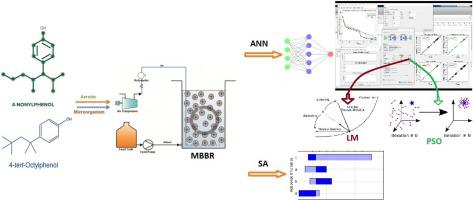当前位置:
X-MOL 学术
›
Biochem. Eng. J.
›
论文详情
Our official English website, www.x-mol.net, welcomes your feedback! (Note: you will need to create a separate account there.)
Modeling and sensitivity analysis of the Alkylphenols removal via moving bed biofilm reactor using artificial neural networks: Comparison of Levenberg Marquardt and Particle Swarm Optimization training algorithms
Biochemical Engineering Journal ( IF 3.9 ) Pub Date : 2020-09-01 , DOI: 10.1016/j.bej.2020.107685 Farzaneh Mohammadi , Bijan Bina , Hossein Karimi , Somayeh Rahimi , Zeynab Yavari
Biochemical Engineering Journal ( IF 3.9 ) Pub Date : 2020-09-01 , DOI: 10.1016/j.bej.2020.107685 Farzaneh Mohammadi , Bijan Bina , Hossein Karimi , Somayeh Rahimi , Zeynab Yavari

|
Abstract Alkylphenols (APs) are nonionic surfactants with toxic and estrogenic properties. APs from municipal and industrial wastewater are frequently detected in surface waters. Therefore, a broadly accepted method for the treatment of APs is needed. The moving-bed bioreactor (MBBR) is an effective process for micropollutant elimination. In this study, the modeling of 4-nonylphenol (4-NP) and 4-tert-octylphenol (4-t-OP) removal from synthetic wastewater using MBBR was performed. Also, a comparison was made between the multilayer perceptron artificial neural network (MLPNN) trained with the traditional Levenberg Marquardt (LM) and the particle swarm optimization (PSO) algorithms. The performance of MBBR in removing chemical oxygen demand (COD) and APs was predicted using the COD surface area loading rate (SALR), COD volumetric loading rate (VLR), hydraulic retention time (HRT), and the initial concentration of APs. The results showed that the best transfer functions are Tan-sigmoid in the hidden layer and Purelin in the output layer. The number of optimal neurons was 5:9:3 for LM and 5:11:3 for PSO. Moreover, the network trained with PSO algorithm was slightly more predictive (R = 0.9997 MSE = 2.526e-5, MAE = 0.0041) than the traditional LM algorithm (R = 0.9989, MSE = 2.582e-5, MAE = 0.0043), especially by increasing the number of neurons. Finally, a sensitivity analysis was performed using ANN-PSO and Pearson correlation, and the results were completely compatible.
中文翻译:

使用人工神经网络通过移动床生物膜反应器去除烷基酚的建模和敏感性分析:Levenberg Marquardt 和粒子群优化训练算法的比较
摘要 烷基酚(APs)是一种具有毒性和雌激素特性的非离子表面活性剂。来自市政和工业废水的 AP 经常在地表水中检测到。因此,需要一种被广泛接受的治疗 AP 的方法。移动床生物反应器(MBBR)是一种有效的微污染物消除工艺。在本研究中,对使用 MBBR 从合成废水中去除 4-壬基苯酚 (4-NP) 和 4-叔辛基苯酚 (4-t-OP) 进行了建模。此外,还对使用传统 Levenberg Marquardt (LM) 训练的多层感知器人工神经网络 (MLPNN) 和粒子群优化 (PSO) 算法进行了比较。MBBR 在去除化学需氧量 (COD) 和 APs 方面的性能通过 COD 表面积负载率 (SALR)、COD 体积负载率 (VLR)、水力停留时间 (HRT) 和 AP 的初始浓度。结果表明,最好的传递函数是隐藏层的Tan-sigmoid和输出层的Purelin。LM 的最佳神经元数量为 5:9:3,PSO 为 5:11:3。此外,用 PSO 算法训练的网络比传统的 LM 算法(R = 0.9989,MSE = 2.582e-5,MAE = 0.0043)更具预测性(R = 0.9997 MSE = 2.526e-5,MAE = 0.0041),尤其是通过增加神经元的数量。最后,使用 ANN-PSO 和 Pearson 相关进行敏感性分析,结果完全一致。LM 为 9:3,PSO 为 5:11:3。此外,用 PSO 算法训练的网络比传统的 LM 算法(R = 0.9989,MSE = 2.582e-5,MAE = 0.0043)更具预测性(R = 0.9997 MSE = 2.526e-5,MAE = 0.0041),尤其是通过增加神经元的数量。最后,使用 ANN-PSO 和 Pearson 相关进行敏感性分析,结果完全一致。LM 为 9:3,PSO 为 5:11:3。此外,用 PSO 算法训练的网络比传统的 LM 算法(R = 0.9989,MSE = 2.582e-5,MAE = 0.0043)更具预测性(R = 0.9997 MSE = 2.526e-5,MAE = 0.0041),尤其是通过增加神经元的数量。最后,使用 ANN-PSO 和 Pearson 相关进行敏感性分析,结果完全一致。
更新日期:2020-09-01
中文翻译:

使用人工神经网络通过移动床生物膜反应器去除烷基酚的建模和敏感性分析:Levenberg Marquardt 和粒子群优化训练算法的比较
摘要 烷基酚(APs)是一种具有毒性和雌激素特性的非离子表面活性剂。来自市政和工业废水的 AP 经常在地表水中检测到。因此,需要一种被广泛接受的治疗 AP 的方法。移动床生物反应器(MBBR)是一种有效的微污染物消除工艺。在本研究中,对使用 MBBR 从合成废水中去除 4-壬基苯酚 (4-NP) 和 4-叔辛基苯酚 (4-t-OP) 进行了建模。此外,还对使用传统 Levenberg Marquardt (LM) 训练的多层感知器人工神经网络 (MLPNN) 和粒子群优化 (PSO) 算法进行了比较。MBBR 在去除化学需氧量 (COD) 和 APs 方面的性能通过 COD 表面积负载率 (SALR)、COD 体积负载率 (VLR)、水力停留时间 (HRT) 和 AP 的初始浓度。结果表明,最好的传递函数是隐藏层的Tan-sigmoid和输出层的Purelin。LM 的最佳神经元数量为 5:9:3,PSO 为 5:11:3。此外,用 PSO 算法训练的网络比传统的 LM 算法(R = 0.9989,MSE = 2.582e-5,MAE = 0.0043)更具预测性(R = 0.9997 MSE = 2.526e-5,MAE = 0.0041),尤其是通过增加神经元的数量。最后,使用 ANN-PSO 和 Pearson 相关进行敏感性分析,结果完全一致。LM 为 9:3,PSO 为 5:11:3。此外,用 PSO 算法训练的网络比传统的 LM 算法(R = 0.9989,MSE = 2.582e-5,MAE = 0.0043)更具预测性(R = 0.9997 MSE = 2.526e-5,MAE = 0.0041),尤其是通过增加神经元的数量。最后,使用 ANN-PSO 和 Pearson 相关进行敏感性分析,结果完全一致。LM 为 9:3,PSO 为 5:11:3。此外,用 PSO 算法训练的网络比传统的 LM 算法(R = 0.9989,MSE = 2.582e-5,MAE = 0.0043)更具预测性(R = 0.9997 MSE = 2.526e-5,MAE = 0.0041),尤其是通过增加神经元的数量。最后,使用 ANN-PSO 和 Pearson 相关进行敏感性分析,结果完全一致。

























 京公网安备 11010802027423号
京公网安备 11010802027423号